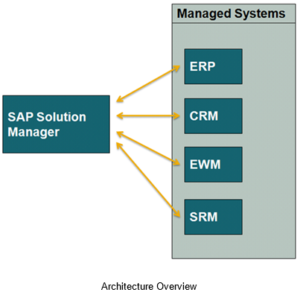SAP Solution Architecture
Leading corporate software provider SAP (Systems, Applications, and Products in Data Processing) is renowned for its integrated business solutions. The design and organization of the numerous software components and modules that SAP offers to support various business processes inside an organization is referred to as SAP solutions architecture. Businesses utilize SAP systems to handle a range of tasks, including managing finances, human resources, supply chains, customer relationships, and more.
Here is an overview of the key elements of SAP solution architecture:
Modules from SAP: SAP provides a variety of software modules, each of which is intended to address a particular business purpose. Enterprise resource planning (ERP), customer relationship management (CRM), supply chain management (SCM), human capital management (HCM), business warehouse and business intelligence (BW/BI), and SAP S/4HANA (an intelligent ERP suite) are a few of the most popular SAP modules. The architecture of SAP systems normally focuses on choosing and integrating the pertinent modules in accordance with the requirements of the organization.
Layer of Integration: SAP systems are made to integrate with other company processes and departments. The integration layer is a critical element that enables seamless data sharing and communication between various SAP modules and external systems. To help with this integration, SAP offers technologies like SAP Process Integration (PI) and SAP Cloud Integration.
Database: To store and manage data, SAP solutions typically use a relational database management system (DBMS). Oracle, Microsoft SQL Server, SAP HANA, and other databases are supported by SAP. Particularly effective at speeding up data processing is the in-memory database SAP HANA.
Application Layer: The many SAP software programmers and applications that run on top of the database make up the application layer of the SAP solution architecture. These programmed manage particular business procedures and offer user interfaces for communication. Examples of user interfaces for working with SAP applications include SAP Fiori and SAP GUI (Graphical User Interface).
User interaction with SAP applications is handled by the presentation layer. It encompasses user interfaces, such as those seen in desktop, mobile, and web applications. An intuitive user experience is offered by SAP Fiori, a popular and contemporary interface.
Infrastructure: A key component of the architecture of the SAP solution is the underlying hardware and network infrastructure. The deployment of SAP products can take place on-premises, in the cloud (such as SAP Cloud Platform), or in a hybrid environment. Scalability, performance, and cost are only a few variables that can be affected by the infrastructure decision.
Security and Authorization: Robust security procedures are built into SAP solutions to secure sensitive data and guarantee that only users with the proper authorization can access certain features and data. User authentication, role-based access control, and encryption are all involved in this.
SAP solutions frequently come with built-in analytics and reporting tools to assist organizations in making data-driven decisions. Examples of business intelligence and reporting tools include SAP Business Objects and SAP Analytics Cloud.
SAP systems can be extended and customized by businesses to fit their own business requirements. In order to accomplish this, SAP offers development frameworks and tools including SAP Cloud Platform, SAP ABAP (Advanced Business Application Programming), and SAP Business Application Studio.
Lifecycle Management: It’s crucial to manage the entire lifecycle of SAP solutions. This covers tasks including system configuration, upkeep, updates, and installation.
Depending on the needs, size, and sector of each organization, the SAP system design can differ greatly. The purpose is to create a safe, scalable, and efficient architecture that supports the organization’s operational goals and procedures. To ensure that SAP solutions are successfully integrated into the organization’s overall IT landscape, coordination between SAP solution architects, business analysts, and IT specialists is frequently required.


































